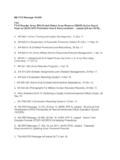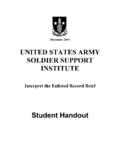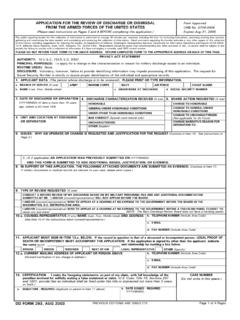Transcription of Educating Noncommissioned Officers - NCO History
1 Educating Noncommissioned Officers A chronological study on the development of educational programs for army Noncommissioned Officers CSM Daniel K. Elder Fort Riley, Kansas Copyrighted July 1999 This file retreived from The NCO Historical 1999 by Dan Elder, All Rights ReservedTable of Contents Introduction Early History of NCO Education Schools for Noncommissioned Officers Post World War II and Occupation Duty The Constabulary School The Noncommissioned Officers Course The Birth of an NCO Academy Standardizing NCO Academies Studying the Effects of NCO Training The NCO Candidate Course Project Proficiency The Beginning of NCOES The Sergeants Major Course The Enlisted Personnel Management System The Evolution The 1990 s, and Beyond Bibliography and Works Consulted This file retreived from The NCO Historical 1999 by Dan Elder, All Rights Reserved Introduction It is too much practice to commit the charge of the elementary drills to non-commissioned Officers .
2 By which great many evils are chance of finding non-commissioned Officers who can clearly comprehend and explain the principles of good discipline is not one in twenty. - William Duane, Regulations for theDiscipline of the Infantry, 1814 Throughout History , training Noncommissioned Officers of the United States army had been accomplished using on-the-job training (OJT) in the unit, and many believed that is where it should stay. Training Noncommissioned Officers was conducted by Officers in the regiment and was the commanding officer s responsibility. It was accepted that unit training was the best means of developing Noncommissioned Officers and potential Noncommissioned Officers . It was not until the post-World War II era that NCO training was conducted outside the unit at specially designed schools and academies.
3 The first Sergeant Major of the army , William O. Wooldridge, noted that in those days a soldier had to provide for his own education and training. "I went to night school. There were no requirements to attend school if you didn't want to. Now you must get training or you don't get promoted." The NCO corps was not always considered as a professional organization. Unlike the officer corps, noncoms did not have a formal system of professional development. Never had there been a prescribed career pattern or explicit career guidance for NCOs, particularly a system of education and training. Up until the end of the draft in 1972, the army had benefited from a limitless source of manpower through selective service. The draft brought an abundance of educated men to be trained who filled the ranks and many only served one term of enlistment.
4 After the draft ended the need to develop a career management program became evident and Educating NCOs became key to building a professional corps of Noncommissioned Officers . To date, there has been little detailing of the History of Noncommissioned Officers and until recently, was given little consideration. In most early writings the NCO was regarded with the enlisted man and as such received little interest. This writing attempts to capture a portion of the History of NCO education and brings together many known sources, expands on the minimal writings, and corrects some deficiencies of recent literature. Early History of NCO Education They should teach the soldiers of their squads how to dress with a soldier-like air, how to clean their arms, accoutrements, etc. and how to mount and dismount their firelocks.
5 - Instructions for the Sergeant and Corporal,von Steuben's 1779 "Blue Book" One of the earliest mentions of Educating Noncommissioned Officers outside the unit was during the early days of the Continental army . When Prussian officer Friedrich von Steuben arrived at Valley Forge he recognized many problems, particularly in discipline, supply, and training. As he set out to restore discipline, Steuben developed tactics using a simple form of manual of arms. In March 1778 General George Washington ordered an additional 100 men to This file retreived from The NCO Historical 1999 by Dan Elder, All Rights ReservedEducating Noncommissioned Officers the Commander in Chief s Guard to serve as participants in Steuben s experiment, the development of a new Continental army .
6 Steuben began by drilling one squad, then allowed subinspectors to drill other squads under his supervision. Officers distanced themselves from the soldiers in the British tradition, but Steuben encouraged them to use sergeants to pass instructions to the drilling troops. Washington was so impressed with the results that he directed that all drilling stop under the current system and that Steuben s simple methods be used. Though later the Officers applied Steuben s techniques to train the soldiers of their troops and regiments, this is probably one of the earliest examples of a specially designed school to train both Noncommissioned Officers and Officers outside the unit. The army was demobilized four days after the war s formal end, except for 600 men to guard the supplies of the army .
7 Many Americans felt at the time that a large standing army in peacetime could infringe on the liberties of the nation. In response, Congress called for states to maintain militias. By May 1792 the basic militia law was passed which called for the enrollment of "every able-bodied white male citizen between 18 and 45 and the organization of the militia into divisions, brigades, regiments, battalions, and companies by the individual states, each militiamen providing his own arms, munitions, and other accouterments." These companies predecessor to the National Guard, met regularly and were trained by elected Officers . Baron von Steuben courtesy Center for Military History The army had suffered without skilled technicians since the Revolution and many, including Gen.
8 S Washington and Henry Knox, had recommended the development of a military school. In 1802 personnel from the newly created Corps of Engineers were assigned to West Point to serve as the staff for a Military Academy to teach military science to select Officers and formal military training was introduced to the army . Secretary of War John C. Calhoun proposed the first specialist school in 1824, in that a school of practice be established, from which the Artillery School at Fortress Monroe was developed. Unlike modern schools which taught individuals, this school taught entire units, including enlisted men. It was closed 11 years later in 1835 when the students were sent to Florida in response to the Seminole threat and reopened in 1858. By the mid 1870 s the school was training Noncommissioned Officers in the History of the United States, geography, reading, writing, and mathematics.
9 In 1868, the Signal Corps established a signal school of instruction which was opened at Fort Greble and, in 1869, moved to Fort Whipple (later Fort Myer). By 1871 the Signal School at Whipple had a primary duty to train observer-sergeants and assistant observers in their duties. Candidates were selected from the enlisted men of the signal detachment and were designated as assistant observers. They were taught subjects on military signaling, telegraphy, and meteorology and pursued a regular course of study. The candidate was promoted to observer-sergeant after completing their studies, six-months of practical application and appearing before an examination board of Officers . Similar to the Artillery and Signal Schools, other schools appeared. The School of Application for Infantry and Cavalry at Fort Leavenworth, the Engineer School of Application This file retreived from The NCO Historical 1999 by Dan Elder, All Rights ReservedEducating Noncommissioned Officers at Fort Totten, New York and the army Medical School were also established in the mid to late 1800's.
10 Most of the Educating was conducted indoors, except for the less technical courses, such as infantry and cavalry. Signal School, circa 1920 courtesy Center for Military History Around the time of the Civil War Maj. Gen. Silas Casey called for NCO training in his book on tactics, insisting that NCOs be formally trained to give commands on the battlefield. But he had to overcome the opposition of company grade Officers . They argued that company commanders knew their men's capabilities and limitations best and were in a better position to provide them on-the-job training. A minority of Officers doubted that OJT could meet the needs for the combat arms and wanted more post schools. But World War I would begin with NCOs receiving traditional unit instruction, while Officers ' schools multiplied. Schools for Noncommissioned Officers The object of training and instructing a company is to thoroughly knit together its different parts, its various elements (individuals, squads and platoons), into a complete, homogeneous mass, a cohesive unit, that will under any and all conditions and circumstances respond to the will of the captain.










